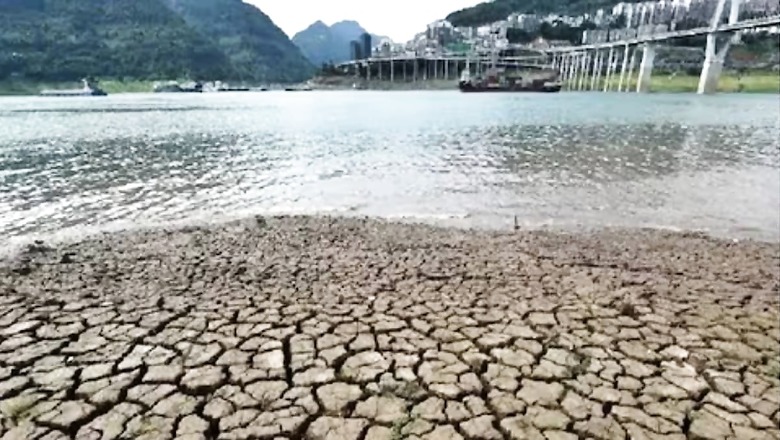
views
Strengthening concerns of rainfall deficit in the upcoming monsoon season, the India Meteorological Department (IMD) has said that there is nearly 70 per cent probability of an El Nino this year. As per experts, El Nino that follows a La Nina year tends to result in a significant shortage of rainfall, which in turn may threaten agricultural production and other aspects of India’s economy.
There is a 70 per cent probability of El Nino in the June, July, and August season, the IMD said, according to a report by Hindustan Times. As per the weather department, the probability rises to 80 per cent in July, August and September seasons.
Earlier, on April 11, IMD said India is expected to get normal rainfall during the southwest monsoon season despite the evolving El Nino conditions. This came even as the agency decided to set up advisory services and forecasts for each country’s 700-odd districts based on different rainfall scenarios among steps to protect farmers.
ALSO READ: El Nino Conditions Predicted in July Now, How Will It Impact India’s Monsoon Season?
What is El Nino and La Nina?
El Nino is the monsoon-disrupting weather pattern, triggered by a warming of the eastern equatorial Pacific Ocean, causing climate chaos across the globe and, often, drought in India.
El Nino, which is the warming of the waters in the Pacific Ocean near South America, is generally associated with the weakening of monsoon winds and dry weather in India.
La Nina, which is the opposite of El Nino, typically brings good rainfall during the monsoon season.
India has already seen four consecutive years of ‘normal’ and ‘above-normal’ rains during the monsoon season. The evolving El Nino conditions this year follow three consecutive La Nina years.
‘Monsoon Critical for India’
The monsoon is the lifeblood of India, the world’s fifth-largest economy. Normal rain is critical for India’s agricultural landscape, with 52 per cent of the net cultivated area relying on it, as it lacks irrigation access, making the rain-bearing system vital.
It is also crucial for the replenishing of reservoirs critical for drinking water apart from power generation across the country.
Rainfed agriculture accounts for about 40 per cent of the country’s total food production, making it a crucial contributor to India’s food security and economic stability.
El Nina causes climate chaos across the globe and, often brings drought in India.
India’s Contingency Plan
The Central weather agency is providing states with customised forecasts to prepare for any adverse condition in advance, the HT report quoted an IMD official as saying,
As per the report, IMD, this year, will provide agro-meteorological advisory services and forecasts for each of India’s 700-odd districts based on different rainfall scenarios, which will be disseminated through Krishi Vigyan Kendras, a network of federally-run farm centres.
What Do Experts Say?
Raghu Murtugudde, visiting professor, Earth System Scientist at IIT Bombay and Emeritus Professor at the University of Maryland, said though only 60 per cent of El Nino years have recorded ‘below normal’ rainfall from in the June-September period, “analysis shows that an El Nino that follows a La Nina year tends to be the worst case scenario in terms of monsoon deficits”.
Between 2001 and 2020, India witnessed El Nino conditions for seven years. Of these, four –2003, 2005, 2009-10, 2015-16– years resulted in droughts, leading to a significant output decline in Kharif or summer-sown crop harvest.
The scientist, however, said that despite three consecutive years of La Nina, the Eurasian precipitation has been slightly below normal which would favour a stronger monsoon and may offset the El Nino impact.
Dr Anjal Prakash, research director, Bharti Institute of Public Policy, Indian School of Business, said while 40 per cent of the El Nino years have resulted in normal or above normal monsoon, 60 per cent have seen deficient rainfall.
“Why do we take smaller denominations rather than understanding the larger trends that show that El Nino has an impact on monsoon rainfall patterns,” he asked.
What Did IMD Say Earlier?
Mrutyunjay Mohapatra, Director General of Meteorology, IMD, had on Tuesday said that positive India Ocean Dipole (IOD) conditions are expected during the southwest monsoon season and the snow cover over the northern hemisphere and Eurasia has also been below normal from December 2022 to March 2023. Both these factors are considered favourable for the southwest monsoon.
According to the IMD, El Nino conditions are expected to develop around July, and their impact may be felt in the second half of the monsoon season.
The IOD is defined by the difference in the sea surface temperatures between the western parts of the Indian Ocean near Africa and the eastern parts of the ocean near Indonesia.
“If at all there is any adverse impact due to the evolving El Nino conditions during the monsoon season, it is likely to be countered by the favourable impact of positive IOD and the lower snow cover over the northern hemisphere,” the IMD chief had said.
Murtugudde said the impact of IOD on the monsoon is not very robust.
“It is likely that the monsoon itself impacts the IOD. If an IOD does occur following a normal monsoon, then the chicken-and-egg narrative will play out again. But remembering that the monsoon is a monstrous heat source and the IOD mostly occurs after the monsoon has nearly ended, we must focus on late-season extremes in dry and wet spells,” he said.
On Thursday, US government forecasters increased the chances of an El Nino to 74 per cent from 61 per cent a month ago.
What is Normal Rainfall?
According to the IMD, rainfall between 96 per cent and 104 per cent of a 50-year average of 87 cm is considered ‘normal’.
Rainfall less than 90 per cent of the long-period average is considered ‘deficient’, between 90 per cent and 95 per cent is ‘below normal’, between 105 per cent and 110 per cent is ‘above normal’ and more than 100 per cent is ‘excess’ precipitation.
Read all the Latest India News here



















Comments
0 comment